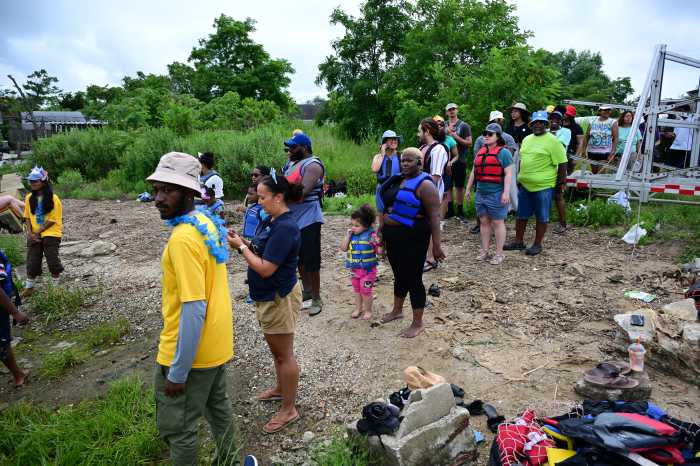By J.B. Nicholas
Volume 80, Number 18 | September 30 – October 6, 2010
West and East Village, Chelsea, Soho, Noho, Little Italy, Chinatown and Lower East Side, Since 1933
Explosions, fires, fouled water: Welcome to hydrofracking hell
DIMOCK TOWNSHIP, Penn. —
It started with a bang.
Here, amid the postcard-perfect hills and hollows of the Allegheny Mountains, Norma Fiorentino, 66, lives in a trailer. In the winter, arctic winds blow down from the north, across the frozen Great Lakes. It was out into this cold that Fiorentino stepped on New Year’s Day 2008 to visit her daughter. While she was out, the well that supplies her home with water exploded, shattering the 8-inch-thick, concrete slab that had capped it. When Fiorentino returned, she found the slab split in two on her snow-sprinkled lawn, as well as a frothy, orange liquid bubbling from her faucets. First she dialed 911, then neighbors. One by one, she discovered that her neighbors’ water, too, had become discolored and cloudy, fetid and foul tasting.
It was a mystery fit for “The X-Files.”
The Pennsylvania State Department of Environmental Protection stepped in and opened an investigation. The agency tested Fiorentino’s water and found methane, the active chemical component of natural gas. Eyes then turned to the drilling rigs that sat atop a hill near her home. They had appeared months earlier, and had been burrowing more than a mile beneath the hills, seeking out ancient shale deposits from which, for the first time, emerging technology had made the harvest of natural gas profitable. D.E.P. soon determined that the drilling had indeed been responsible for the explosion of Fiorentino’s well, in addition to the contamination of her neighbors’ water.
The cause lay in the drilling method used to extract the gas, known as hydraulic fracturing, or “hydrofracking” for short. The drilling had destroyed the natural barrier separating the aquifer, from which the area’s well water was being drawn, and the shale formation, in which the gas was being mined, causing gas to seep into the water.
Dimock’s deposit is part of the Marcellus Shale formation, a remnant of the time, eons ago, when this part of the world was covered by an inland sea. It lies beneath a good part of four states, stretching from New York’s Southern Tier, southwest through much of Pennsylvania, into eastern Ohio and down through West Virginia. Embedded in the formation are vast reserves of natural gas. Before 2008 it was thought, based on research conducted by the U.S. Geological Survey, that the amount of natural gas recoverable from the Marcellus Shale was a relatively nominal amount that would not make large-scale mining cost effective.
Things changed, however, in early 2008 when a State University of New York professor published revised figures. The new numbers revealed that there was enough natural gas in the formation to supply all the United States for two years, at a total value of about $1 trillion.
The shale gold rush was on.
One after another, the landmen came to Dimock and began knocking on doors. Landmen are charged by their oil-company bosses with negotiating mineral-rights leases. They offered $25 an acre, plus 12.5 percent of royalties. To most people in this principally agricultural town, which had only recently begun the march into modernity, with pockets of poverty persisting, the amount was irresistible.
But, in fact, the landmen had always come to Dimock. And the farmers had always taken their money, mostly because no company had ever come around to make good on its claims. As Frank Finlin, a longtime Dimock resident, put it, “The farmers signed the leases and said, ‘Free hay this year!’ ”
This time, however, the companies returned, and they brought some new, astoundingly powerful equipment with them.
Developed by transnational energy giant Halliburton, the goal of hydrofracking is, in short, to supercharge a well’s production by literally cracking open the rock into which it has been drilled. The first step is to drill a standard wellbore. The well is then capped in a way that allows chemical-laden fluids under ultra-high pressure to be injected into it. The rock formations surrounding the wellbore then fracture, allowing more gas and oil to flow into the reservoir into which the well has been drilled, increasing output. Substances called “propants,” which are blended into the fracking fluid, hold open the well, preventing the fracked rock from closing. Gas is then harvested from the well, and transported to a refinery via a network of pipelines.
While this basic technology has been around for decades, fracking’s reach, and thus its impact on the environment, was limited because rigs could drill straight down, but not sideways. Over the last two decades, however, oil companies developed steerable drill heads, so now gas miners can drill horizontally. Using sophisticated electronic monitoring and other technology, drillers can even guide the fracturing process, actually controlling the direction in which the rock shatters.
This quantum leap in technological drilling know-how has opened up vast, new underground territories to gas prospecting.
In 2007 there were two natural gas wells in Dimock. Today, there are more than 40, and landowners are routinely offered $5,000 and more per acre for mineral rights leases, plus 20 percent of any royalties.
In the meantime, Norma Fiorentino, whose water well exploded, was still living in her trailer. She said she repeatedly implored the company responsible to supply them with clean water — or at least to cover the costs of their getting their own clean water — but the company, Cabot Oil & Gas of Houston, Texas, steadfastly refused.
“I’ve begged him since my well blew up to give me water,” Fiorentino said, referring to Kenneth Komoroski, the company’s lawyer and spokesman. “But he’s never given me a bottle.” So, she had no choice but to spend a portion of her meager fixed income on bottled water, or travel to the next town over to draw water from a spring.
She was not alone.
Victoria Switzer, 57, a retired teacher, moved to Dimock with her husband to build their dream house. Like her neighbor Fiorentino, Switzer signed a lease with Cabot when the company’s landman came knocking, receiving a onetime payment of $180 per acre, with monthly royalty checks around $900. Like everyone else here, in the early days of the boom, she had no idea of the trouble that was headed her way.
Then, on a cold, clear March night in 2008, Switzer awoke to find her dog staring out a window, transfixed by a huge flame shooting skyward from the drilling rig behind her house, causing the surrounding forest to glow gold in a harrowing vision straight out of Dante’s “Inferno.” Soon after, her water, like her neighbor’s, turned orange and frothy.
Altogether, in the area surrounding Cabot’s gas wells, 14 Dimock families lost their water. Today, pursuant to a judicially enforceable consent decree signed by the gas company with Pennsylvania D.E.P., Cabot is obligated to find a permanent solution to the problem. In the meantime, its tanker trucks deliver water to the affected families every day, filling large containers called water buffaloes that have been integrated into the homes’ water supply.
It’s impossible to understate the impact the gas gold rush has had on Dimock and all its people, not just the 14 families who lost their drinking water.
Where once there were barns and silos and green fields that grew corn and other produce, drilling rigs now soar into the sky. Where once forested hills undulated unbroken for miles, now a growing patchwork of dirt roads fragment the forest, along with new pipelines to transport the extracted gas. Where once there was quiet, now there is a cacophony of clanking, hissing and roaring. Where once there was cool, clean air, now there are diesel fumes and particulates. Caravans of 18-wheeler trucks rumble around, tearing up the roads. At night, the rigs’ white lights illuminate the black skies, looking not like manmade machines so much as alien spacecraft come to colonize the land.
More than this, fracking fluid itself contains toxic chemicals, and the gas companies have refused to disclose what, exactly, those chemicals are.
“Your drinking water goes from clear and fine, to a week later being yellow-colored, sediment on the bottom, foam on the top and an oily smell to it,” said Daniel Farnham, an environmental engineer. Farnham tested the wells and found industrial solvents, such as ethylene glycol, propylene glycol, toluene and ethylbenzene, in “virtually every sample” taken from water wells in Dimock, according to a report by the Associated Press.
Though the industry has refused to publicly disclose the compounds in its fracking cocktails, ethylene glycol, propylene glycol and toluene are listed on the Pennsylvania D.E.P.’s Web site as chemicals used by hydraulic fracturing companies in the state. With the exception of propylene glycol, all are toxic chemicals, and some are known carcinogens.
The contamination, said Farnham, is “not a figment of anybody’s imagination.”
Multiple, independent tests confirm Farnham’s conclusions.
Meanwhile, the landmen have already invaded New York State, and have already secured drilling leases in the state’s Southern Tier, including counties in which New York City maintains several reservoirs. But the state and its residents have pushed back, effectively imposing a ban on fracking. Mayor Bloomberg, an environmentalist — though often seen as too close a friend of big business — has been an outspoken fracking opponent. So, too, has been Governor Paterson. Much maligned as New York’s accidental, bumbling governor, one of Paterson’s first official acts was to issue a de facto moratorium on hydrofracking. And, this past summer, the state Senate passed a bill placing an official moratorium on fracking until 2011.
The state Assembly has yet to act on the bill.
Whoever is elected in November is going to have to face the issue head on and decide whether to allow fracking in New York State. And with the gas industry holding the momentum, and with the state desperately in need of additional tax revenue, even a Democratic win won’t guarantee the continuation of the de facto fracking ban.
In fact, Andrew Cuomo, the Democratic nominee, has pointedly refused to disclose his stance on the issue, even in the face of anti-fracking protests on his Upstate campaign trail.
Switzer, one of the Dimock residents who originally allowed gas drilling on her land, only to later become an opponent after it ruined her water supply, traveled to New York a few weeks ago to voice her opposition to fracking at a public hearing in Upstate Binghamton. New Yorkers tempted by gas industry money, she said, should take caution from her experience.
“I feel like one of the Indians who sold Manhattan for beads and baubles,” she said.
The gas industry maintains that fracking is safe.





































